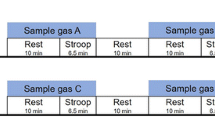This study investigated the effect of 30% oxygen administration on verbal cognitive performance, blood oxygen saturation, and heart rate. Five male (24.6(±0.9) years) and five female (22.2(±1.9) years) college students were selected as the subjects for this study. Two psychological tests were developed to measure the performance level of verbal cognition. The experiment consisted of two runs: one was a verbal cognition task, with normal air (21% oxygen) administered and the other was with hyperoxic air (30% oxygen) administered. The experimental sequence in each run consisted of Rest 1 (1 min), Control (1 min), Task (4 min), and Rest 2 (4 min). Blood oxygen saturation and heart rate were measured throughout the four phases. The results of the verbal behavioural analysis reveal that accuracy rates were enhanced with 30% oxygen administration compared to 21% oxygen. When 30% oxygen was supplied, blood oxygen saturation was increased significantly compared to that with 21% oxygen administration, whereas heart rate showed no significant difference. Significant positive correlations were found between changes in oxygen saturation and cognitive performance. This result supports the hypothesis that 30% oxygen administration would lead to increases in verbal cognitive performance.





Similar content being viewed by others
References
Andersson, J., Berggren, P., Gronkvist, M., Magnusson, S., & Svensson, E. (2002). Oxygen saturation and cognitive performance. Psychopharmacology (Berlin), 162, 119–128.
Backs, R. W., & Seljos, K. A. (1994). Metabolic and cardiorespiratory measures of mental effort: The effects of level of difficulty in a working memory task. International Journal of Psychophysiology, 16, 57–68.
Benton, D. (2001). The impact of the supply of glucose to the brain on mood and memory. Nutrition Reviews, 59, S20–S21.
Chung, S. C., Tack, G. R., Kim, I. H., Lee, S. Y., & Sohn, J. H. (2004). The effect of highly concentrated oxygen administration on cerebral activation levels and lateralization in visuospatial tasks. Integrative Physiological and Behavioral Science, 39, 153–165.
Degel, J., & Koster, E. P. (1999). Odours: Implicit memory and performance effects. Chemical Senses, 24, 317–325.
Knutson, B., Bjork, J. M., Fomg, G. W., Hommer, D., Mattay, V. S., & Weinberger, D. R. (2004). Amphetamine modulates human incentive processing. Neuron, 43, 261–269.
Kuwert, T., Homberg, V., Steinmetz, H., Unverhau, S., Langen, K. J., Herzog, H., & Feinendegen, L. E. (1993). Posthypoxic amnesia — regional cerebral glucose consumption measured by positron emission tomography. Journal of Neurological Sciences, 118, 10–16.
Lee, S. R. (1982). Intelligence Test 151-Ga Type (High School Students ∼ Adults). Seoul, Korea: Jungangjucksung Press.
Lee, S. R. & Kim, K. R. (1985). Aptitude Test 251-Ga (High School Students ∼ Adults). Seoul, Korea: Jungangjucksung Press.
Lieberman, H. R. (2001). The effects of ginseng, ephedrine, and caffeine in cognitive performance, mood and energy. Nutrition Reviews, 59, 91–102.
Lorist, M. M., & Tops, M. (2003). Caffeine, fatigue, and cognition. Brain and Cognition, 53, 82–94.
Malik, M. (1996). Heart rate variability. Standard of measurement, physiological interpretation, and clinical use. Circulation, 93, 1043–1065.
Mattay, V. S., Callicott, J. H., Bertolino, A., Heaton, I., Frank, J. A., Coppola, R., Berman, K. F., Goldberg, T. E., & Weinberger, D. R. (2000). Effects of dextroamphetamine on cognitive performance and cortical activation. NeuroImage, 12, 268–275.
Messier, C. (2004). Glucose improvement of memory: A review. European Journal of Pharmacology, 490, 33–57.
Metzger, M. M. (2000). Glucose enhancement of a facial recognition task in young adults. Physiology and Behavior, 68, 549–553.
Moss, M. C., & Scholey, A. B. (1996). Oxygen administration enhances memory formation in healthy young adults. Psychopharmacology (Berlin), 124, 255–260.
Moss, M. C., Scholey, A. B., & Wesnes, K. (1998). Oxygen administration selectively enhances cognitive performance in healthy young adults: A placebo-controlled double blind crossover study. Psychopharmacology (Berlin), 138, 27–33.
Moss, M., Cook, J., Wesnes, K., & Duckett, P. (2003). Aromas of rosemary and lavender essential oils differentially affect cognition and mood in healthy adults. International Journal of Neuroscience, 113, 15–38.
Ruijter, J., Lorist, M. M., Snel, J., & De Ruiter, M. (2000). The influence of caffeine on sustained attention: An ERP study. Pharmacology, Biochemistry and Behaviour, 66, 29–38.
Scholey, A. B., Moss, M. C., & Wesnes, K. A. (1998). Oxygen and cognitive performance: The temporal relationship between hyperoxia and enhanced memory. Psychopharmacology (Berlin), 140, 123–126.
Scholey, A. B., Moss, M. C., Neave, N., & Wesnes, K. (1999). Cognitive performance, hyperoxia, and heart rate following oxygen administration in healthy young adults. Physiology and Behavior, 67, 783–789.
Scholey, A. B., & Fowles, K. A. (2002). Retrograde enhancement of kinesthetic memory by alcohol and by glucose. Neurobiology of Learning and Memory, 78, 585–592.
Sunram-Lea, S. I., Foster, J. K., Durlach, P., & Perez, C. (2001). Glucose facilitation of cognitive performance in healthy young adults: Examination of the influence of fast-duration, time of day and pre-consumption plasma glucose levels. Psychopharmacology (Berlin), 157, 46–54.
Turner, L. A., & Carroll, D. (1985). Heart rate and oxygen consumption during mental arithmetic, a video game, and graded exercise: Further evidence of metabolically-exaggerated cardiac adjustments. Psychophysiology, 22, 261–267.
Winder, R., & Borrill, J. (1998). Fuels for memory: The role of oxygen and glucose in memory enhancement. Psychopharmacology (Berlin), 136, 349–356.
Acknowledgments
This work supported by the Konkuk University in 2006.
Author information
Authors and Affiliations
Corresponding author
Rights and permissions
About this article
Cite this article
Chung, SC., Iwaki, S., Tack, GR. et al. Effect of 30% Oxygen Administration on Verbal Cognitive Performance, Blood Oxygen Saturation and Heart Rate. Appl Psychophysiol Biofeedback 31, 281–293 (2006). https://doi.org/10.1007/s10484-006-9023-5
Published:
Issue Date:
DOI: https://doi.org/10.1007/s10484-006-9023-5




